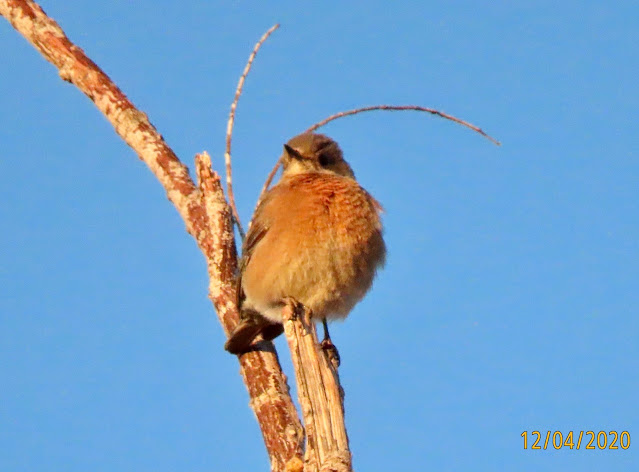Wednesday, December 16, 2020
To participate in an Audubon event that began on Christmas Day in 1900 is a privilege not taken lightly by me. Most years, I participate in several such citizen science counts of types and numbers of birds seen and heard over the course of one day throughout the 20-days assigned to the Count. But with Covid-19 on the rise in Arizona, I limited myself to just one Christmas Bird Count (CBC) event that was totally outdoors with masked and distanced participants.
For purposes of the Christmas Bird Count, Lake Pleasant Regional Park is divided into various areas. This was my second Count on the Lake itself. Boarding Pontoon Boat #2 at 9:30 a.m., three birders, a Fish & Wildlife pilot and a co-pilot (learning how to guide a bird count on the lake) enabled us to maintain Covid protective protocols on a boat that holds 20 people. Three birders plus Mary Mc, pilot and birder in Pontoon Boat #1 with three additional birders covered the west side of the Lake in the morning as we covered the dam and east side.
While our group did not tally a really high number of species, the birds were ones I rarely see in my day-to-day birding at local areas. After docking for lunch around 1 a.m. (carried lunch and ate outside the restaurant on dock), we set out for our turn at the west side while Boat #1 covered the east side.
Marceline V. and I were in the front of the boat; Louis H. took the captain's chair enabling him to swivel from side to side. While he maintained the official CBC list for our group, his sharp eyes helped pull out individuals in flocks.
Photos from my day at Scorpion Bay follow with brief comments:
BLACK-THROATED SPARROW observed early in the parking lot above Scorpion Bay.
We came upon repeated flocks of COMMON GOLDENEYE comparing the count in each group to be certain we weren't counting a flock that flew off and landed ahead of us. Spooked easily by the quiet boat, it was difficult to get decent photos with my point-and-shoot camera. All remaining photos were taken from the boat but calm waters helped get pictures.

Compared to the flighty Common Goldeneye, the WESTERN and CLARK'S GREBE large flotillas just dived as we approached and moved as we coasted among them. At least 500 and above in count, we floated through them, catching individuals as they surfaced and swam about.
1. WESTERN GREBE; 2. CLARK'S GREBE; 3. CLARK'S & WESTERN GREBE
Lake Pleasant is full of rocky islands containing shrubs, cacti and trees. So, we had a few passerines as well as waterfowl as we cruised around many miles of lake. The LOGGERHEAD SHRIKE remained high in its tree to observe us. Although I missed a photo of the ROCK WREN and the SAY'S PHOEBE, I managed to catch the CANYON WREN on a flat rock watching us pass by. 
Multiple sightings of GREAT BLUE HERON were mostly too distant for my camera, but finally one remained on a rock as we floated past...before taking off.
Also on shore, we spotted four burro that are common around the regional park.

Perched on top of a saguaro, a large RED-TAILED HAWK surveyed its area.
Back on the lake, a COMMON LOON was diving....hiding...leaving us to keep seeking! Gotcha!
Surprised that we had not yet seen any Eared or Horned Grebe, I was about to call a Horned Grebe because of a nice white cheek, but when I looked at its bill, I was stumped. Louis called it: RED-THROATED LOON! My most recent sighting of that species had been in Anchorage a few years back when it was in breeding plumage that blew my mind and stayed in my mind. So, I didn't recognize it now in its winter feathering, although I used to see it on Canyon Lake when I knew its winter plumage!
 RED-THROATED LOON above in non-breeding plumage without its neck extended; and below in Anchorage, AK in May, 2018. What a difference!!
RED-THROATED LOON above in non-breeding plumage without its neck extended; and below in Anchorage, AK in May, 2018. What a difference!!Terry, our pilot who works for Fish & Wildlife knew of a BALD EAGLE NEST in a saguaro. Having never seen what must be a giant nest in a saguaro before, I kept looking for it. Finally, we reached it; Terry pointed it out. It didn't appear occupied this year, but as we pulled away, a BALD EAGLE flew above the rocks in that direction. Whether because we were on the water below it or it had no intention of stopping, we don't know but it moved on past.

To be out on the water all day was the personification of the lake's name, pleasant. During multiple crises in our daily lives, this was a cherished feeling.
Back at the parking lot at 4:30 p,m. I was dreading traffic on the 101. Marceline happened to mention she exited at Shea. That's a good idea for me, too, I thought. Go home the back way. And, I did: directly through Fountain Hills with its Christmas Lights, to Highway 87, to Bush Highway past my favorite Salt River birding sites almost hidden by dusk turning dark. So little traffic on that entire route once past the developed area, I must do it again. It was only about ten minutes longer than my morning drive to the Lake and, it would have taken much longer in the traffic I had avoided. So, my day ended up with no erasure of the pleasant tone of this limited social Christmas Bird Count 2020.
* * *
View this checklist online at https://ebird.org/checklist/S77573514
View this checklist online at https://ebird.org/checklist/S77573515
View this checklist online at https://ebird.org/checklist/S77573516

































